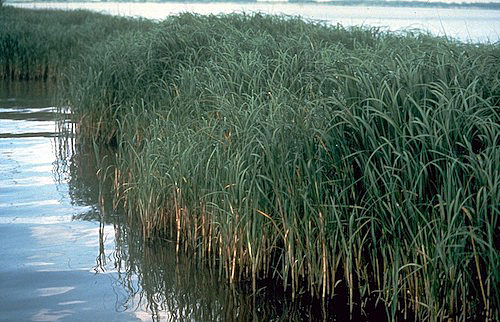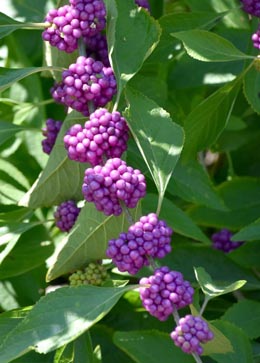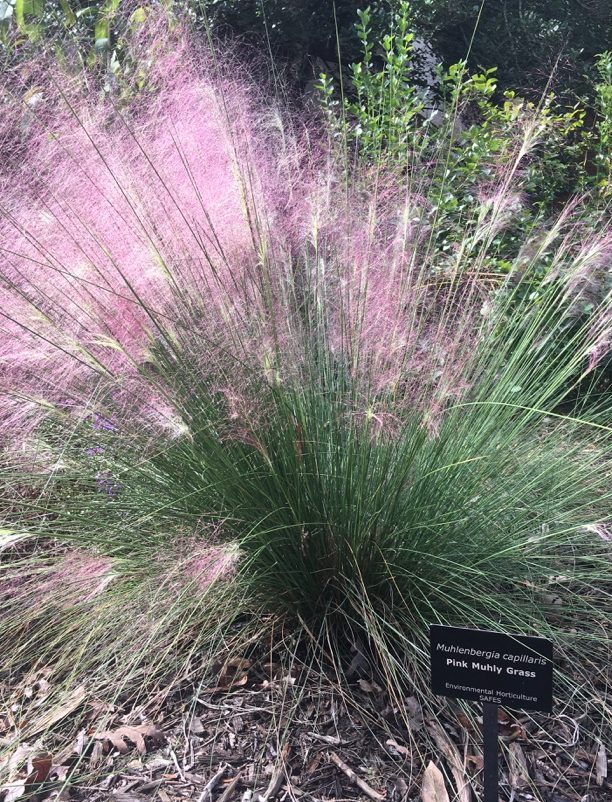Halophytes: Plants That Grow in Salty Environments
By Ann M. Mason, Fairfax Master Gardener
 Most of us are familiar with typical garden plants. But some gardeners are challenged by saltier soils and water sources. As our environment and climate shift, more areas may face the challenges of increasing salinity. Our coastlines are already familiar with salt spray. In the future, coastal areas may face rising sea levels changing and expanding coastal marshes and riverine shores. As some water wells deplete freshwater aquifers, salt water intrusion will alter the salinity levels in water sources. As our growing population expands into arid and semi-desert areas for homes and farms, they will confront challenges about identifying plants, especially edibles and crops, that will survive. While none of these situations may apply, gardeners can unknowingly choose winter deicers, chemical fertilizers or organic soil amendments (or their overapplication) that can, over time, degrade soil quality by adding excess sulfates, nitrates and sodium and calcium bicarbonates.
Most of us are familiar with typical garden plants. But some gardeners are challenged by saltier soils and water sources. As our environment and climate shift, more areas may face the challenges of increasing salinity. Our coastlines are already familiar with salt spray. In the future, coastal areas may face rising sea levels changing and expanding coastal marshes and riverine shores. As some water wells deplete freshwater aquifers, salt water intrusion will alter the salinity levels in water sources. As our growing population expands into arid and semi-desert areas for homes and farms, they will confront challenges about identifying plants, especially edibles and crops, that will survive. While none of these situations may apply, gardeners can unknowingly choose winter deicers, chemical fertilizers or organic soil amendments (or their overapplication) that can, over time, degrade soil quality by adding excess sulfates, nitrates and sodium and calcium bicarbonates.
Why do gardeners care about salinity? Excess salts from soils and water can accumulate in plant cells and tissues. This accumulation lowers the plant’s osmosis process, which reduces the consumption of water. Salts cause dehydration. Increasing salts cause the stomata in leaves to close. This closure reduces the amounts of carbon dioxide that can enter the leaf and oxygen leaving the leaf. This disruption leads to lower photosynthesis and lower shoot and leaf production. In short, excess salt concentrations stress most plants, which leads to stunted growth, burned leaves and plant death.
For decades, scientists have been studying plants and crops that can survive increasing salt levels in our soils and water. Let’s glean a few insights about these salt-tolerant plants called halophytes.
To understand salinity let’s start with a little chemistry. Salinity is usually influenced by soluble salts (mostly sodium and chloride) and is measured using an electrical charge (electrical conductivity as expressed in dS/m, short for deciSiemens per meter). Also, sodium can bind to the soil particles ionically and displace other elements including calcium and magnesium. This elemental shift impacts roots and plant growth. The salinity of water is measured by the total dissolved solids (TDS) which is the weight or concentration of the inorganic particles (mg/L or parts per million, ppm, respectively). There is an approximate relationship of electrical charge to TDS: one dS/m roughly equates to about 650 to 750 ppm or so.
Most gardeners nourish our plants with non-saline water (less than 0.7 dS/m). Our Virginia coastal areas may have brackish water (0.7 to 2.0 dS/m) and saline water (above 2.0 dS/m). Many of us collect rainwater to nourish our gardens (0.02 to 0.05 dS/m). Rain, non-saline and brackish waters that contain soluble salts less than 4 dS/m can nourish plants and crops. Generally, water and soils containing salt levels above 4 dS/m inhibit germination and plant and crop growth.
So, what can gardeners do to grow plants in places where soils or water have soluble salt content at or over 4.0 dS/m?
First, gardeners can improve drainage to reduce salt accumulation especially in the root zone. Salts decrease water uptake. Gardeners who see soil with surface crusts of salt will want to remove and replace that soil with non-saline topsoil. Breaking up and deeply tilling dense claypans soils can improve water and air flow. For those areas without adequate drainage, additional measures are needed to improve flushing and leaching of salts from soil.
Second, soil test(s) inform gardeners about the salt levels in soil. Soil tests identify the cation exchange capacity (CEC), whether soluble salts are present at levels to cause a problem, and the pH (above 8.5 indicates sodic soil).
Third, gardeners can choose to grow salt-tolerant plants especially those with deep roots that improve the soil. Below are listed some salt-tolerant plants that will grow in USDA Hardiness Zone 7. These lists will give the gardener a starting place to look for salt tolerant plants. NOTE: Some of these plants are invasive or non-native species.

Beautyberry berries
Seashore mallow (Kosteletzkya virginica);
Agave (Agave spp.);
Mazari palm (Nannorrhops ritchiana);
Salt cedar (Tamarix spp.);
Russian olive (Elaeagnus angustifolia);
Thornless honey locust (Gleditsia triacanthos);
Sumac (Rhus spp.);
Northern red oak (Quercus rubra);
White oak (Quercus alba);
Rugosa rose (Rosa rugosa);
Elm hybrids (Ulmus hybrids);
Juniper (Juniperus spp.);
White spruce (Picea glauca);
Mugo pine (Pinus mugo);
Southern red cedar (Juniperus virginiana);
American Holly (Ilex opaca);
Magnolia (Magnolia grandiflora);
Yaupon holly (Ilex vomitoria);
American beautyberry (Callicarpa americana);
Coastal sweet pepperbush (Clethra alnifolia);
Red buckeye (Aesculus pavia);
Bee balm (Monarda didyma);
Seaside goldenrod (Solidago sempervirens);
Sea myrtle (Baccharis halimifolia)

Muhly grass
Sea oats (Uniola paniculata),
Alkali sacaton (Sporobolus airoides);
Crowfoot grass (Dactyloctenium aegyptium);
Pearl millet (Pennisetum typhoides);
Salicornia (Salicornia spp.);
Wild rice (Zizania aquatica);
Muhly grass (Muhlenbergia capillaris);
Coastal little bluestem (Schizachyrium littorale)
Fodder and green manure
Alfalfa or Lucerne (Medicago sativa);
Bermuda grass (Cynodon dactylon);
birdsfoot trefoil (Lotus corniculatus)
Crops, fruits, nuts [some have landscape value]
asparagus (Asparagus officinalis);
rapeseed (Brassica napus);
beets (Beta vulgaris);
sorghum (Sorghum bicolor);
barley (Hordeum vulgare);
rye (variety of genus including Elymus, Leymus, Lolium, and Secale);
cattail (Typha angustifolia);
Ceylon spinach (Basella alba and B. rubra);
Chinese wolfberry (Lycium barbarum);
Goose tongue (Plantago maritima);
Jujube (Ziziphus mauritiana);
Mazari palm (Nannorrhops ritchiana);
Oak-leaved goosefoot (Chenopodium glaucum);
Sea aster (Aster tripolium);
Sea fennel (Crithmum maritimum);
Salicornia (Salicornia spp.);
Sea kale (Crambe maritima);
Sea orach (Atriplex halimus);
Sea rocket (Cakile maritima);
Spanish dagger (Yucca whipplei);
Water chestnut (Trapa natans);
White mulberry (Morus alba)
Resources
• Biosalinity Awareness Project, a non-profit organization to promote awareness of and solutions to
salinity issues in our environment
• Plants for a Future has a searchable database of plants.
• The Impact of Salts on Plants and How to Reduce Plant Injury from Winter Salt Applications, University
of Massachusetts Amherst
• Managing Soil Salinity, Tony Provin and J.L. Pitt, Texas A&M University Extension
• Basics of Salinity and Sodicity Effects on Soil Physical Properties, Krista E. Pearson, Montana State
University Extension
• Salt Tolerant Plants for the South Carolina Coast, Barbara H. Smith, Clemson Cooperative Extension
• Salt Tolerant Landscapes, Terra Freeman, University of Florida/Institute of Food & Agricultural Sciences
Extension, St. Johns County
• Salt Tolerant Plants Recommended for Pender County Landscapes, Charlotte Glen, North Carolina
Cooperative Extension
• Saline Agriculture, Salt-tolerant plants for developing countries, National Research Council. 1990.
• Selecting Salt-tolerant native trees for the Georgia Coast, Bodie V. Pennisi and John M. Ruter, University
of Georgia Extension, Bulletin 1477
• Plant Salt Tolerance, Catherine M. Grieve, Stephen R. Grattan and Eugene V. Maas, 2012, Chapter 13,
Agricultural Salinity Assessment and Management, American Society of Civil Engineers, Reston, VA
• Salt/Salinity Tolerance of Common Horticulture Crops in South Dakota, Rhoda Burrows and Lance Stott,
South Dakota State University Extension
• Salt Tolerant Vegetable Gardening, Theresa Badurek, University of Florida Extension